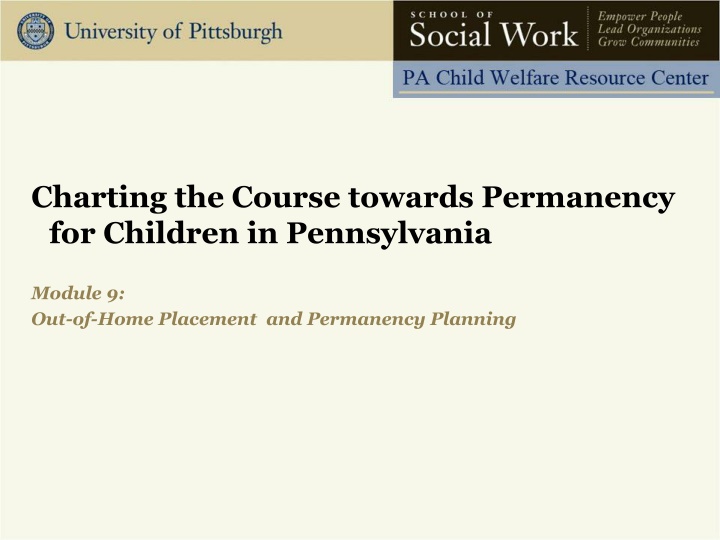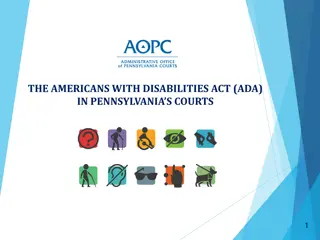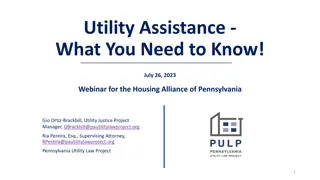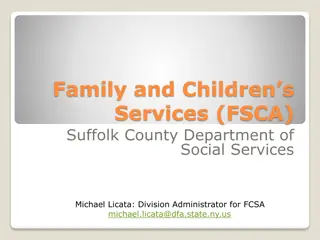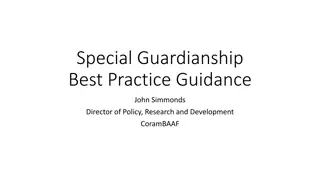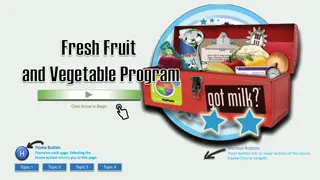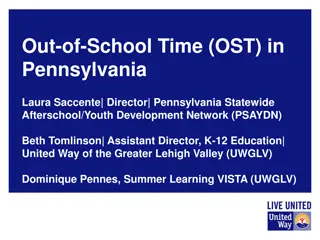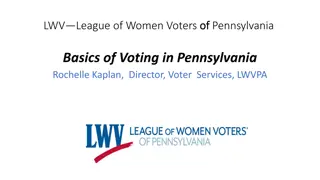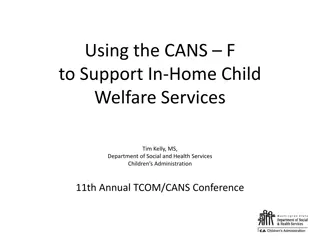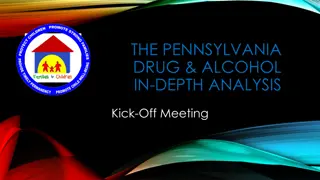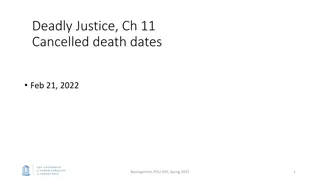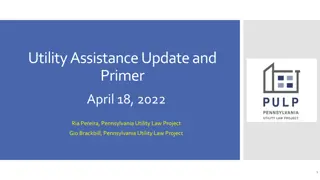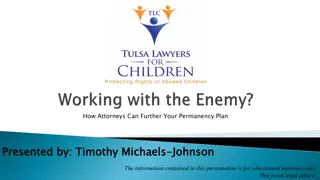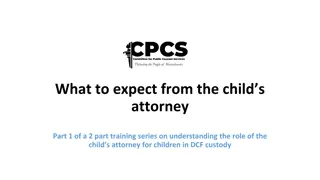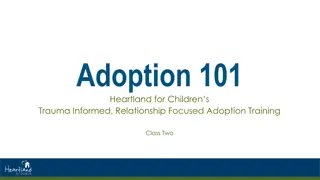Navigating Permanency for Children in Pennsylvania
Module 9 of the Pennsylvania Child Welfare Resource Center provides detailed insights into out-of-home placement and permanency planning. The module covers topics such as the importance of permanency, concurrent planning, visitation, and child permanency plan review. Participants will learn about the impact of permanency on children, timeframes for achieving timely permanence, concurrent planning benefits, family engagement strategies, and the components of a Child Permanency Plan.
Download Presentation

Please find below an Image/Link to download the presentation.
The content on the website is provided AS IS for your information and personal use only. It may not be sold, licensed, or shared on other websites without obtaining consent from the author.If you encounter any issues during the download, it is possible that the publisher has removed the file from their server.
You are allowed to download the files provided on this website for personal or commercial use, subject to the condition that they are used lawfully. All files are the property of their respective owners.
The content on the website is provided AS IS for your information and personal use only. It may not be sold, licensed, or shared on other websites without obtaining consent from the author.
E N D
Presentation Transcript
Charting the Course towards Permanency for Children in Pennsylvania Module 9: Out-of-Home Placement and Permanency Planning
SECTION I: Introduction The Pennsylvania Child Welfare Resource Center Module 9: Out-of-Home Placement and Permanency Planning 2
Agenda Day One Introduction The Importance of Permanency Supporting Children, Parents, and Substitute Caregivers throughout the Placement Process Permanency Goals Overview The Pennsylvania Child Welfare Resource Center Module 9: Out-of-Home Placement and Permanency Planning 3
Agenda, (contd) Day Two What is Concurrent Planning? Clear Timelines Finding Family Teaming Engagement The Pennsylvania Child Welfare Resource Center Module 9: Out-of-Home Placement and Permanency Planning 4
Agenda, (contd) Day Three Visitation Child Permanency Plan Review and Summary The Pennsylvania Child Welfare Resource Center Module 9: Out-of-Home Placement and Permanency Planning 5
Learning Objectives Participants will be able to: State the impact of permanency on a child; Identify the timeframes established in law to achieve timely permanence; Explain how concurrent planning supports the achievement of timely permanence, as well as reflects the best interests of a child; Identify teaming and family engagement strategies that support timely permanence; and Recognize the required components of a Child Permanency Plan (CPP). The Pennsylvania Child Welfare Resource Center Module 9: Out-of-Home Placement and Permanency Planning 6
SECTION II: The Importance of Permanency Section Objectives: Cite ways to consider permanency at various stages of casework practice. Give an example of the importance and impact of permanency. The Pennsylvania Child Welfare Resource Center Module 9: Out-of-Home Placement and Permanency Planning 7
What is Permanency? The establishment of an identified adult or family who has made a commitment to care for and to support a child up to and beyond the age of majority (PA Concurrent Planning Bulletin) will continue onward to provide enduring family connections and supports into adulthood (PA Quality Service Review Protocol) The Pennsylvania Child Welfare Resource Center Module 9: Out-of-Home Placement and Permanency Planning 8
Pennsylvanias Practice Model Outcome: Permanence Children, youth, families, child welfare representatives and other child and family service partners participate as team members with shared community responsibility to achieve and maintain . Enduring and certain permanence and timely achievement of stability, supports and lifelong connections The Pennsylvania Child Welfare Resource Center Module 9: Out-of-Home Placement and Permanency Planning 9
Video Worksheet: Multiple Transitions Directions: Discuss and compare answers to the worksheet questions within your group. The Pennsylvania Child Welfare Resource Center Module 9: Out-of-Home Placement and Permanency Planning 10
Basic Permanency Assumptions Children have a right and a need to live and develop within safe, secure, and permanent families. Children have a right to live with parents/caregivers whom they can love, trust, and depend upon. Separation for extended periods of time may result in tremendous psychological and developmental disruption. A child s perception and experience of time are determined by his/her level of cognitive developmental maturity. The Pennsylvania Child Welfare Resource Center Module 9: Out-of-Home Placement and Permanency Planning 11
What is Permanency Planning? Permanency planning is, first and foremost, planning. Process directed toward the goal of a permanent, stable home for a child. Begins at intake, and focuses child welfare services on the child's need for a stable, permanent home during all phases of practice. The Pennsylvania Child Welfare Resource Center Module 9: Out-of-Home Placement and Permanency Planning 12
What is Permanency Planning? (contd) Step-by-step process of assessment, identification of goals and objectives, formulation of activities, and reassessment of the outcomes of services. Reminds us - All case planning activities MUST be directed toward assuring that every child in our care has a permanent family. The Pennsylvania Child Welfare Resource Center Module 9: Out-of-Home Placement and Permanency Planning 13
Idea Catcher Don t Let Ideas Get Away! The Pennsylvania Child Welfare Resource Center Module 9: Out-of-Home Placement and Permanency Planning 14
SECTION III: Supporting Children, Parents, and Substitute Caregivers Throughout the Placement Process Section Objectives: Identify actions a child welfare professional can take to help minimize the traumatic effects of placement. Apply appropriate interactional skills to plan a supportive response that keeps the parent engaged. The Pennsylvania Child Welfare Resource Center Module 9: Out-of-Home Placement and Permanency Planning 15
Advice on Placement What could I have done to better help you leave your family the first time? What did you want from me to help you to prepare to leave your new family? Would you still want to see the family you left behind? What help did you need to make this return successful? The Pennsylvania Child Welfare Resource Center Module 9: Out-of-Home Placement and Permanency Planning 16
Minimizing the Trauma of Placement Identify at least four things a child welfare professional can do to help minimize the traumatic effects of placement. The Pennsylvania Child Welfare Resource Center Module 9: Out-of-Home Placement and Permanency Planning 17
Benefits of Involving Parents in Placement Process Maintains involvement Maintains parenting role and responsibilities Reassures the child Reinforces the importance of parents Enhances relationship between parents and child welfare professionals It empowers parents. It provide for consistency of children s care. The Pennsylvania Child Welfare Resource Center Module 9: Out-of-Home Placement and Permanency Planning 18
Instructions for Completing Handout #10 (Incorporating Interactional Helping Skills into Placement Practice) 1. Review each situation with your partner. 2. Identify how you are feeling. 3. Explore (tuning in) how that person you speak with might be thinking or feeling about the situation. 4. Select one Interactional Helping Skill, besides tuning into others that may be especially useful when working through this particular issue. 5. Brainstorm with your partner ways in which to formulate a response that employs this skill. The Pennsylvania Child Welfare Resource Center Module 9: Out-of-Home Placement and Permanency Planning 19
The Needs of Older Youth Brainstorm In pairs, brainstorm the unique areas of need for older youth. The Pennsylvania Child Welfare Resource Center Module 9: Out-of-Home Placement and Permanency Planning 21
Six Service Areas of IL Education/Training Employment Housing Life Skills Prevention/Wellness Support/Permanent Connections The Pennsylvania Child Welfare Resource Center Module 9: Out-of-Home Placement and Permanency Planning 22
Act 91 of 2012 Effective July 5, 2012 Allowed for resumption of jurisdiction for youth to return to out-of-home care beyond age 18 until age 21 by amending the definition of Child in the Juvenile Act The Pennsylvania Child Welfare Resource Center Module 9: Out-of-Home Placement and Permanency Planning 20
Idea Catcher Don t Let Ideas Get Away! The Pennsylvania Child Welfare Resource Center Module 9: Out-of-Home Placement and Permanency Planning 23
SECTION IV: Permanency Goals Section Objectives: Identify the correct order of the permanency goal hierarchy. Recognize characteristics of the goals in the permanency goal hierarchy. Recognize strengths and concerns of the goals in the permanency goal hierarchy. The Pennsylvania Child Welfare Resource Center Module 9: Out-of-Home Placement and Permanency Planning 24
Hierarchy of Permanency Goals 1. Return to Parents (AKA Reunification) 2. Adoption 3. Permanent Legal Custody (PLC) 4. Permanent Placement with a Fit and Willing Relative 5. Another Planned Permanent Living Arrangement (APPLA) The Pennsylvania Child Welfare Resource Center Module 9: Out-of-Home Placement and Permanency Planning 25
Activity: Permanency Goal - Descriptions Directions: Select Recorder and Spokesperson Review Handout #12 (Permanency Goal Descriptions) Answer the 5 questions: 1. Condition(s) for Finalization 2. Custody Status at Finalization 3. Agency Case Status 4. Parental Rights 5. Source of Financial Support The Pennsylvania Child Welfare Resource Center Module 9: Out-of-Home Placement and Permanency Planning 26
Extra Source of Financial Support for Older Youth Extended adoption subsidies for eligible youth Under the age of 21 years Attained 13 years of age before adoption assistance agreement was finalized Met certain conditions Extended guardianship (PLC) subsidies for eligible youth Amended and added several definitions Act 80 of 2012: Effective July 1, 2012 The Pennsylvania Child Welfare Resource Center Module 9: Out-of-Home Placement and Permanency Planning 27
Idea Catcher Don t Let Ideas Get Away! The Pennsylvania Child Welfare Resource Center Module 9: Out-of-Home Placement and Permanency Planning 28
Agenda Day One Introduction The Importance of Permanency Supporting Children, Parents, and Substitute Caregivers throughout the Placement Process Permanency Goals Overview The Pennsylvania Child Welfare Resource Center Module 9: Out-of-Home Placement and Permanency Planning 29
Agenda, (contd) Day Two What is Concurrent Planning? Clear Timelines Finding Family Teaming Engagement The Pennsylvania Child Welfare Resource Center Module 9: Out-of-Home Placement and Permanency Planning 30
Agenda, (contd) Day Three Visitation Child Permanency Plan Review and Summary The Pennsylvania Child Welfare Resource Center Module 9: Out-of-Home Placement and Permanency Planning 31
SECTION V: What is Concurrent Planning? Section Objectives: Define concurrent planning. Explain why Pennsylvania employs concurrent planning as a permanency planning strategy. Recognize the eight components of a good concurrent plan. The Pennsylvania Child Welfare Resource Center Module 9: Out-of-Home Placement and Permanency Planning 32
Sequential Planning Time .. Failure Plan B Plan A Success Permanency The Pennsylvania Child Welfare Resource Center Module 9: Out-of-Home Placement and Permanency Planning 33
Consequences of Sequential Planning ? The Pennsylvania Child Welfare Resource Center Module 9: Out-of-Home Placement and Permanency Planning 34
What is Concurrent Planning? Plan A Option Plan B Alternative The Pennsylvania Child Welfare Resource Center Module 9: Out-of-Home Placement and Permanency Planning 35
What is Concurrent Planning? (contd) A process of working toward one legal permanency goal (typically reunification) while at the same time establishing and implementing an alternative permanency goal Both goals are worked on concurrently to move children/youth more quickly to a safe and stable permanent family. ASFA cites concurrent planning as a best practice The Pennsylvania Child Welfare Resource Center Module 9: Out-of-Home Placement and Permanency Planning 36 (Permanency Roundtable Project, 2010)
Goals of Concurrent Planning To promote the safety, permanency and well- being of children and youth in out-of-home care; To achieve timely permanency for children and youth through early permanency decisions; To reduce the number of moves in the foster care system for children; and To engage families and relatives early and foster significant relationships between children in out-of- home care and their family/kin. The Pennsylvania Child Welfare Resource Center Module 9: Out-of-Home Placement and Permanency Planning 37
Activity: Potential Advantages and Challenges of Concurrent Planning The Pennsylvania Child Welfare Resource Center Module 9: Out-of-Home Placement and Permanency Planning 38
Who Gets a Concurrent Plan? Effective July 1, 2015: Effective January 1, 2016: All children entering foster care with a goal of reunification will have a concurrent plan established within 90 days of their placement. All children who were already in out-of- home care will have a concurrent plan regardless of their court-ordered permanency goal. Concurrent Planning Policy and Implementation Bulletin # 3130-12-03 The Pennsylvania Child Welfare Resource Center Module 9: Out-of-Home Placement and Permanency Planning 39
Eight Core Components of Concurrent Planning 1. Full disclosure to all participants in the case planning process 2. Family search and engagement 3. Family Group Decision Making/Family Group Conferencing/Teaming 4. Child/Family visitation 5. Establishment of clear timelines for permanency decisions 6. Transparent written agreements and documentation 7. Committed collaboration between child welfare agencies, the courts, resource families, service providers, and other stakeholders 8. Specific recruitment, training, and retention of resource families The Pennsylvania Child Welfare Resource Center Module 9: Out-of-Home Placement and Permanency Planning 40 OCYF Bulletin 3130-12-03
Activity: Reviewing the Eight Core Components Directions: Develop the expertise of your group: Review the content together. Work through anything that is not clear. Summarize by answering the questions provided. Make sure all group members are ready to share the summary with others The Pennsylvania Child Welfare Resource Center Module 9: Out-of-Home Placement and Permanency Planning 41
Rapid Review: How would you explain concurrent planning? Why does Pennsylvania employ concurrent planning as a permanency planning strategy? Who gets a concurrent plan? Recap the eight core components of a good concurrent plan. The Pennsylvania Child Welfare Resource Center Module 9: Out-of-Home Placement and Permanency Planning 42
Idea Catcher Don t Let Ideas Get Away! The Pennsylvania Child Welfare Resource Center Module 9: Out-of-Home Placement and Permanency Planning 43
SECTION VI: Clear Timelines Section Objective: Identify timeframes associated with the five permanency goals, as outlined in the Concurrent Planning Bulletin. The Pennsylvania Child Welfare Resource Center Module 9: Out-of-Home Placement and Permanency Planning 44
Handouts Permanency Timelines Permanency Goal Comparisons The Pennsylvania Child Welfare Resource Center Module 9: Out-of-Home Placement and Permanency Planning 45
Activity: Pair Share Discuss the two handouts, the information they contain, and ways you may use them as job aids. The Pennsylvania Child Welfare Resource Center Module 9: Out-of-Home Placement and Permanency Planning 46
Concurrent Planning: Reasonable Efforts Toward Both Goals Primary Goal Concurrent Goal The Pennsylvania Child Welfare Resource Center Module 9: Out-of-Home Placement and Permanency Planning 47
A Key Reminder TPR: When to File The earlier of: When grounds exist to file TPR When the child has spent 15 out of 22 months in out-of- home placement Unless an exception applies. The Pennsylvania Child Welfare Resource Center Module 9: Out-of-Home Placement and Permanency Planning 48
A Key Condition: When to Return to Parent? The child is either: Safe or Safe with a safety plan The Pennsylvania Child Welfare Resource Center Module 9: Out-of-Home Placement and Permanency Planning 49
A Sense of Urgency: Finalize Adoption ASAP! Remember: Even when the child is living with the family that intends to adopt him or her, permanency is not yet achieved ! The Pennsylvania Child Welfare Resource Center Module 9: Out-of-Home Placement and Permanency Planning 50
